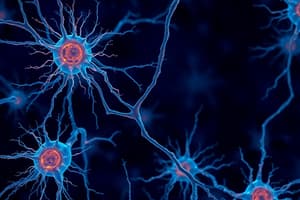Podcast
Questions and Answers
What percentage of cells in the central nervous system are not neurons?
What percentage of cells in the central nervous system are not neurons?
- 70%
- 95%
- 50%
- 90% (correct)
What is the primary function of astrocytes in the central nervous system?
What is the primary function of astrocytes in the central nervous system?
- To synthesize neurotransmitters
- To provide structural support to neurons (correct)
- To act as a barrier to the blood-brain barrier
- To initiate and conduct nerve impulses
What is the role of astrocytes in repair of brain injuries?
What is the role of astrocytes in repair of brain injuries?
- To help in neural scar formation (correct)
- To remove excess neurotransmitters
- To form a scar tissue
- To promote neuronal growth
What is the function of astrocytes in regulating potassium levels in the brain?
What is the function of astrocytes in regulating potassium levels in the brain?
How many major types of glial cells are mentioned in the text?
How many major types of glial cells are mentioned in the text?
What is the role of oligodendrocytes in the central nervous system?
What is the role of oligodendrocytes in the central nervous system?
What type of cells are the scavengers of the central nervous system?
What type of cells are the scavengers of the central nervous system?
What is the function of ependymal cells in the central nervous system?
What is the function of ependymal cells in the central nervous system?
Why do neurons themselves not form tumors?
Why do neurons themselves not form tumors?
What type of brain tumors originate from the meninges?
What type of brain tumors originate from the meninges?
Flashcards are hidden until you start studying
Study Notes
Glial Cells in the Central Nervous System
- Glial cells make up about 90% of the cells in the central nervous system, but only occupy about half the volume of the brain due to their non-extensive branching.
- Glial cells do not initiate or conduct nerve impulses, but are essential for the viability of the central nervous system.
- They serve as the connective tissue of the central nervous system, supporting neurons physically and metabolically.
Types of Glial Cells
- There are four major types of glial cells: astrocytes, oligodendrocytes, ependymal cells, and microglia cells.
Astrocytes
- Provide critical functions, including:
- Holding neurons together in proper spatial relationship
- Aiding in the repair of brain injuries and neural scar formation
- Supporting neurons metabolically
- Taking up excess potassium from the brain extracellular fluid
- Surround brain capillaries with their processes, playing a role in the blood-brain barrier
- Have three major roles: signaling cells to form tight junctions, participating in cross-cellular transport, and serving as supporting frameworks
Oligodendrocytes
- Form insulative myelin sheets around axons in the central nervous system
- Have elongated projections that wrap around sections of intraneuronal axons to form patches of myelin
Ependymal Cells
- Line the internal cavities of the central nervous system, including the ventricles of the brain and the central canal of the spinal cord
- Contribute to the formation of cerebrospinal fluid
Microglia Cells
- Act as scavengers of the central nervous system, removing foreign invaders and tissue debris
- Are fibrocystic cells delivered by the blood to the central nervous tissue, remaining stationary until activated by infection or injury
- Migrate to affected areas to remove foreign substances
Brain Tumors
- Most brain tumors of neural origin consist of glial cells (gliomas) because they can undergo cell division
- Neurons themselves do not form tumors due to their inability to divide and multiply
- Brain tumors of non-neuronal origins include:
- Those that metastasize to the brain from other sites
- Meningiomas, which originate from the meninges (protective membrane covering the central nervous system)
Studying That Suits You
Use AI to generate personalized quizzes and flashcards to suit your learning preferences.




